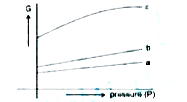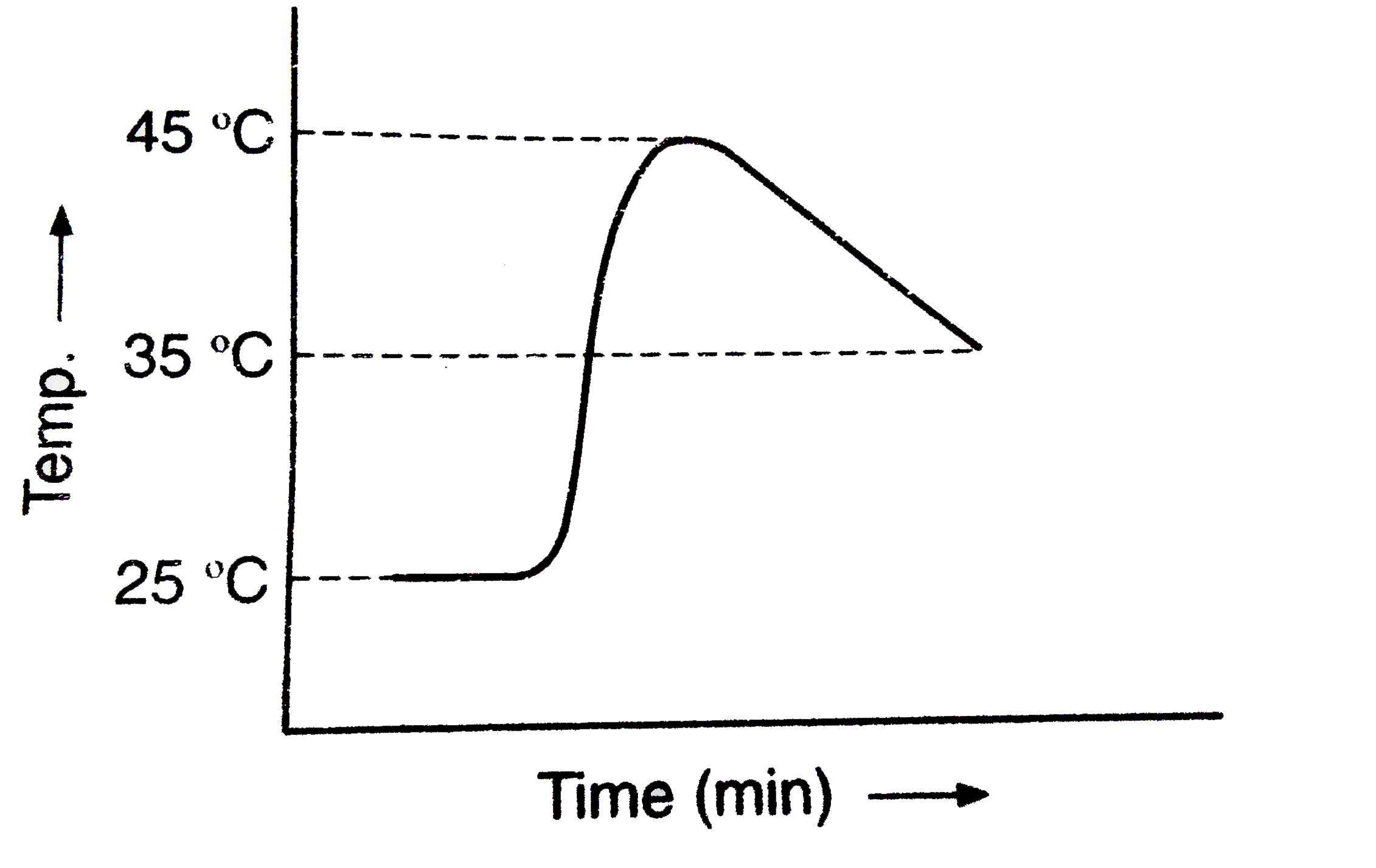Chemical reactions are invariably associated with the transfer of energy either in the form of hear or light. In the laboratory, heat changes in physical and chemical processes are measured with an instrument called calorimeter. Heat change in the process is calculated as: q= ms ΔT, s= Specific heat = cΔT= Heat capacity. Heat of reaction at constant pressure is measured using simple or water calorimeter. Qv=ΔU= Internal energy change, QP=ΔH,QP=QV+PΔVandΔH=ΔU+ΔnRT. The amount of energy released during a chemical change depends on the physical state of reactants and products, the condition of pressure, temperature and volume at which the reaction is carried out. The variation of heat of reaction with temperature and pressure is given by Kirchoff's equation: ΔH2−ΔH1T2−T1=ΔCP (At constant pressure), ΔU2−ΔU1T2−T1=ΔCV (At constant volume)
The enthalpy change (ΔH) for the reaction N2(g)+3H2(g)→2NH3(g) is −92.38kJ at 298 K. The internal energy change ΔU at 298 K isSolution in Telugu
−92.38kJ
−87.42kJ
97.34 kJ
−89.9kJ
The correct Answer is:B
Step by step video, text & image solution for Chemical reactions are invariably associated with the transfer of energy either in the form of hear or light. In the laboratory, heat changes in physical and chemical processes are measured with an instrument called calorimeter. Heat change in the process is calculated as: q= ms Delta T, s= Specific heat = c Delta T= Heat capacity. Heat of reaction at constant pressure is measured using simple or water calorimeter. Q_(v)= Delta U= Internal energy change, Q_(P) = DeltaH, Q_(P) = Q_(V) + P Delta V and DeltaH = Delta U+ Delta nRT. The amount of energy released during a chemical change depends on the physical state of reactants and products, the condition of pressure, temperature and volume at which the reaction is carried out. The variation of heat of reaction with temperature and pressure is given by Kirchoff's equation: (DeltaH_(2) - DeltaH_(1))/(T_(2)-T_(1))= Delta C_(P) (At constant pressure), (DeltaU_(2) - DeltaU_(1))/(T_(2)-T_(1)) = DeltaC_(V) (At constant volume) The enthalpy change (DeltaH) for the reaction N_(2) (g) + 3H_(2)(g) rarr 2NH_(3)(g) is -92.38kJ at 298 K. The internal energy change DeltaU at 298 K is by Chemistry experts to help you in doubts & scoring excellent marks in Class 12 exams.
Topper's Solved these Questions
- BOOK - AAKASH SERIESCHAPTER - CHEMICAL THERMODYNAMICSEXERCISE - Practice Sheet- Exercise-III30videos
CHEMICAL THERMODYNAMICS
- BOOK - AAKASH SERIESCHAPTER - CHEMICAL THERMODYNAMICSEXERCISE - Practice Sheet- Exercise-IV20videos
CHEMICAL THERMODYNAMICS
- BOOK - AAKASH SERIESCHAPTER - CHEMICAL THERMODYNAMICSEXERCISE - Practice Sheet-Exercise-I33videos
CHEMICAL THERMODYNAMICS
- BOOK - AAKASH SERIESCHAPTER - CHEMICAL KINETICSEXERCISE - Objective Exercise - 4 (Assertion (A) & Reason (R) Type Questions)44videos
CHEMICAL KINETICS
- BOOK - AAKASH SERIESCHAPTER - CHEMISTRY IN EVERY DAY LIFEEXERCISE - PRACTICE EXERCISE29videos
CHEMISTRY IN EVERY DAY LIFE
Similar Questions
The following curve represents the variation of Gibbs function 'G' with pressure at constant temperature. Correct match of given plots with the physical state of a substance is
 04:59View Solution
04:59View SolutionFor a perfectly crystalline solid Cp.m=aT3, where a is constant. If Cp.m is 0.42 J/K − mol at 10K, molar entropy at 10K is
01:58View SolutionWhich of the following diagram correctly represents the variation of internal energy (U) of gas under expansion at constant temperature.
06:49View Solution(A) Spontaneous reaction may be slow or fast.
(R ) Spontaneous nature deals with feasibility of the reaction but not rate.View SolutionAnti allergy drugs are
View SolutionChemical reactions are invariably associated with the transfter of energy either in the form of heat or light. In the laboratory, heat changes in physical and chemical processes are measured with an instrument called calorimeter. Heat change in the process is calculated as {:(q = ms DeltaT,,s ="Specific heat"),(=cDeltaT,,c ="Heat capacity"):} Heat of reaction at constant volume is measured using bomb calorimeter. q_(V) = DeltaU = Internal energy change Heat of reaction at constant pressure is measured using simple or water calorimeter. q_(p) = DeltaH q_(p) = q_(V) +P DeltaV DeltaH = DeltaU +DeltanRT The heat capacity of a bomb calorimeter is 500 JK^(-1) . When 0.1g of methane was burnt in this calorimeter, the temperature rose by 2^(@)C . The value of DeltaU per mole will be
View SolutionChemical reactions are invariably associated with the transfter of energy either in the form of heat or light. In the laboratory, heat changes in physical and chemical processes are measured with an instrument called calorimeter. Heat change in the process is calculated as
{:(q = ms DeltaT,,s =Specific heat),(=cDeltaT,,c =Heat capacity):}<br>Heatofreactionatconstantvolumeismeasuredusingbombcalorimeter.<br>q_(V) = DeltaU =Internale≠rgychan≥<br>Heatofreactionatconstantpressureismeasuredusingsimp≤orwatercalorimeter.<br>q_(p) = DeltaH<br>q_(p) = q_(V) +P DeltaV<br>DeltaH = DeltaU +DeltanRT<br>ForwhichreactionwillDeltaH = DeltaU? Assume each reaction is carried out in an open container.View SolutionChemical reactions are invariably associated with the transfter of energy either in the form of heat or light. In the laboratory, heat changes in physical and chemical processes are measured with an instrument called calorimeter. Heat change in the process is calculated as {:(q = ms DeltaT,,s ="Specific heat"),(=cDeltaT,,c ="Heat capacity"):} Heat of reaction at constant volume is measured using bomb calorimeter. q_(V) = DeltaU = Internal energy change Heat of reaction at constant pressure is measured using simple or water calorimeter. q_(p) = DeltaH q_(p) = q_(V) +P DeltaV DeltaH = DeltaU +DeltanRT The enthalpy of fusion of ice is 6.02 kJ mol^(-1) . The heat capacity of water is 4.18 J g^(-1)C^(-1) . What is the smallest number of ice cubes at 0^(@)C , each containing one molw of water, the are needed to cool 500g of liquid water from 20^(@)C to 0^(@)C ?
View SolutionChemical reactions are invariable associated with the transfer of enery either in the form of heat or light. In the laboratory, heat energy I physical and chemical processes are measured with an instrument called caloriemter. Heat change in the process is calcualted as: q-msDeltaT," "s= specific heat =cDeltaT," "c= Heat capacity. Heat of reaction at constant pressure is measured using bomb calorimeter. q_(V)=DeltaU= Internal energy change heat of reaction at constant pressure is measrued using simple or water calorimeter. q_(P)=DeltaH q_(P)=q_(V)+PDeltaV DeltaH=DeltaU+DeltanRT The amount of energy released during a chemical change depends on the physical state of reactants and products, te conditions of pressure, temperatrue and volume at which the reaction is carried out. the variation of heat of reaction with temperature and pressure is given by kirchhoff's equation: (DeltaH_(2)-DeltaH_(1))/(T_(2)-T_(1))=DeltaC_(P)," "(DeltaU_(2)-DeltaU_(1))/(T_(2)-T_(1))=DeltaC_(V) . Q. Matht eh List-I and List-II and select the answer from the given codes:
View SolutionChemical reactions are invariable associated with the transfer of enery either in the form of heat or light. In the laboratory, heat energy I physical and chemical processes are measured with an instrument called caloriemter. Heat change in the process is calcualted as:
q−msΔT, s=specific heat
=cΔT, c= Heat capacity.
Heat of reaction at constant pressure is measured using bomb calorimeter.
qV=ΔU= Internal energy change
heat of reaction at constant pressure is measrued using simple or water calorimeter.
qP=ΔH
qP=qV+PΔV
ΔH=ΔU+ΔnRT
The amount of energy released during a chemical change depends on the physical state of reactants and products, te conditions of pressure, temperatrue and volume at which the reaction is carried out. the variation of heat of reaction with temperature and pressure is given by kirchhoff's equation:
ΔH2−ΔH1T2−T1=ΔCP, ΔU2−ΔU1T2−T1=ΔCV.
Q. The heat capacity of a bomb calorimeter is 500 J/K. When 0.1g of methane was burnt in this calorimeter, the temperature rose by 2∘C. the value of ΔU per mole will be:View SolutionChemical reactions are invariable associated with the transfer of enery either in the form of heat or light. In the laboratory, heat energy I physical and chemical processes are measured with an instrument called caloriemter. Heat change in the process is calcualted as:
q−msΔT, s=specific heat
=cΔT, c= Heat capacity.
Heat of reaction at constant pressure is measured using bomb calorimeter.
qV=ΔU= Internal energy change
heat of reaction at constant pressure is measrued using simple or water calorimeter.
qP=ΔH
qP=qV+PΔV
ΔH=ΔU+ΔnRT
The amount of energy released during a chemical change depends on the physical state of reactants and products, te conditions of pressure, temperatrue and volume at which the reaction is carried out. the variation of heat of reaction with temperature and pressure is given by kirchhoff's equation:
ΔH2−ΔH1T2−T1=ΔCP, ΔU2−ΔU1T2−T1=ΔCV.
Q.
What value of ΔT should be used for the calorimetry experiment that gives the following graphical result?03:03View SolutionChemical reactions are invariable associated with the transfer of enery either in the form of heat or light. In the laboratory, heat energy I physical and chemical processes are measured with an instrument called caloriemter. Heat change in the process is calcualted as:
q−msΔT, s=specific heat
=cΔT, c= Heat capacity.
Heat of reaction at constant pressure is measured using bomb calorimeter.
qV=ΔU= Internal energy change
heat of reaction at constant pressure is measrued using simple or water calorimeter.
qP=ΔH
qP=qV+PΔV
ΔH=ΔU+ΔnRT
The amount of energy released during a chemical change depends on the physical state of reactants and products, te conditions of pressure, temperatrue and volume at which the reaction is carried out. the variation of heat of reaction with temperature and pressure is given by kirchhoff's equation:
ΔH2−ΔH1T2−T1=ΔCP, ΔU2−ΔU1T2−T1=ΔCV.
Q. The enthalpy of fusion of ice is 6.02 kJ mol−1. The heat capacity of water is 4.18Jg−1.∘C−1. What is the smallest number of ice cubes at 0∘C, each containing one mole of water, that are needed to cool 500 g of liquid water from 20C to 0∘C?01:56View SolutionChemical reactions are invariable associated with the transfer of enery either in the form of heat or light. In the laboratory, heat energy I physical and chemical processes are measured with an instrument called caloriemter. Heat change in the process is calcualted as:
q−msΔT, s=specific heat
=cΔT, c= Heat capacity.
Heat of reaction at constant pressure is measured using bomb calorimeter.
qV=ΔU= Internal energy change
heat of reaction at constant pressure is measrued using simple or water calorimeter.
qP=ΔH
qP=qV+PΔV
ΔH=ΔU+ΔnRT
The amount of energy released during a chemical change depends on the physical state of reactants and products, te conditions of pressure, temperatrue and volume at which the reaction is carried out. the variation of heat of reaction with temperature and pressure is given by kirchhoff's equation:
ΔH2−ΔH1T2−T1=ΔCP, ΔU2−ΔU1T2−T1=ΔCV.
Q. The enthalpy change (ΔH) for the reaction,
N2(g)+3H2(g)→2NH2(g)
is -91.38 kJ at 298 K. The nternal energy change ΔU at 298K is:05:20View SolutionChemical reactions are invariable associated with the transfer of enery either in the form of heat or light. In the laboratory, heat energy I physical and chemical processes are measured with an instrument called caloriemter. Heat change in the process is calcualted as: q-msDeltaT," "s= specific heat =cDeltaT," "c= Heat capacity. Heat of reaction at constant pressure is measured using bomb calorimeter. q_(V)=DeltaU= Internal energy change heat of reaction at constant pressure is measrued using simple or water calorimeter. q_(P)=DeltaH q_(P)=q_(V)+PDeltaV DeltaH=DeltaU+DeltanRT The amount of energy released during a chemical change depends on the physical state of reactants and products, te conditions of pressure, temperatrue and volume at which the reaction is carried out. the variation of heat of reaction with temperature and pressure is given by kirchhoff's equation: (DeltaH_(2)-DeltaH_(1))/(T_(2)-T_(1))=DeltaC_(P)," "(DeltaU_(2)-DeltaU_(1))/(T_(2)-T_(1))=DeltaC_(V) . Q. The specific heats of I_(2) in vapour and solid states are 0.031 and 0.055 cal/g respectively. The heat of sublimation of iodine at 200^(@)C is 6.096 kcal mol^(-1) . the heat of sublimation of iodine at 250^(@)C will be:
03:10View SolutionThe heat measured for a reaction in a bomb calorimeter is
03:15View Solution

